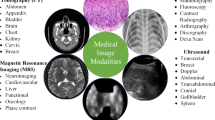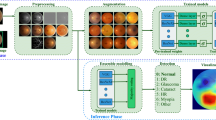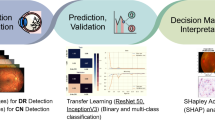Abstract
Glaucoma is a progressive and deteriorating optic neuropathy that leads to visual field defects. The damage occurs as glaucoma is irreversible, so early and timely diagnosis is of significant importance. The proposed system employs the convolution neural network (CNN) for automatic segmentation of the retinal layers. The inner limiting membrane (ILM) and retinal pigmented epithelium (RPE) are used to calculate cup-to-disc ratio (CDR) for glaucoma diagnosis. The proposed system uses structure tensors to extract candidate layer pixels, and a patch across each candidate layer pixel is extracted, which is classified using CNN. The proposed framework is based upon VGG-16 architecture for feature extraction and classification of retinal layer pixels. The output feature map is merged into SoftMax layer for classification and produces probability map for central pixel of each patch and decides whether it is ILM, RPE, or background pixels. Graph search theory refines the extracted layers by interpolating the missing points, and these extracted ILM and RPE are finally used to compute CDR value and diagnose glaucoma. The proposed system is validated using a local dataset of optical coherence tomography images from 196 patients, including normal and glaucoma subjects. The dataset contains manually annotated ILM and RPE layers; manually extracted patches for ILM, RPE, and background pixels; CDR values; and eventually final finding related to glaucoma. The proposed system is able to extract ILM and RPE with a small absolute mean error of 6.03 and 5.56, respectively, and it finds CDR value within average range of ± 0.09 as compared with glaucoma expert. The proposed system achieves average sensitivity, specificity, and accuracies of 94.6, 94.07, and 94.68, respectively.












Similar content being viewed by others
Change history
25 June 2021
A Correction to this paper has been published: https://doi.org/10.1007/s10278-021-00468-9
References
R. N. Weinreb, T. Aung and F. A. Medeiros, "The pathophysiology and treatment of glaucoma: a review," JAMA, vol. 311, no. 18, pp. 1901-1911, 2014.
J. W. Jeoung and K. H. Park, "OCT on the ability to detect localized retinal nerve fiber layer defects in preperimetric glaucoma," Invest Ophthalmol Vis Sci, vol. 51, pp. 938-945, 2010.
A. Sommer, N. R. Miller, I. Pollack, A. E. Maumenee and Terry George, "The nerve fiber layer in the diagnosis of glaucoma," Arch Ophthalmol, vol. 95, no. 12, pp. 2149-56, 1977
K. B. Khan, A. A. Khaliq, A. Jalii, M. A. Iftikhar, N. Ullah, M. W. Aziz, K. Ullah and M. Shahid, "A review of retinal blood vessels extraction techniques: challenges, taxonomy, and future trends," Pattern Anal Applic, vol. 22, no. 3, pp. 767-802., 2019.
D. Huang, E. A. Swanson, C. P. Lin, J. S. Schuman, W. G. Stinson, W. Chang, M. R. Hee, T. Flotte, K. Gregory, C. A. Puliafito and J. G. Fujimoto, "Optical coherence tomography," Science, vol. 254, no. 5035, p. 1178–1181, 1991.
D. W and F. JG., "State-of-the-art retinal optical coherence tomography.," Prog Retin Eye Res, vol. 27, no. 1, p. 45–88., 2008.
A. M. Zysk, F. T. Nguyen, A. L. Oldenburg, D. L. Marks and S. A. Boppart, "Optical coherence tomography: a review of clinical development from bench to bedside.," J Biomed Opt, vol. 12, no. 5, p. 051403, 2007.
G. Wollstein, H. Ishikawa, J. Wang, S. A. Beaton and J. S. Schuman, "Comparison of three optical coherence tomography scanning areas for detection of glaucomatous damage," Am J Ophthalmol, vol. 139:, p. 39–43, 2005.
Y. LeCun, Y. Bengio and G. Hinton, "Deep learning," Nature, vol. 521, p. 436–444, 2015.
Wang YP, Chen Q, Lu ST: Quantitative assessments of cup-to-disk ratios in spectral domain optical coherence tomography images for glaucoma diagnosis. In 2013 6th International Conference on Biomedical Engineering and Informatics, China, 2013.
F. Mohammadimanesh, B. Salehi, M. Mahdianpari, E. Gill and M. Molinier, "A new fully convolutional neural network for semantic segmentation of polarimetric SAR imagery in complex land cover ecosystem," ISPRS J Photogramm Remote Sens, vol. 151, pp. 223-236, 2019.
B. Staar, M. Lütjen and M. Freitag, "Anomaly detection with convolutional neural networks for industrial surface inspection," Procedia CIRP, vol. 79, pp. 484-489, 2019.
G. Singadkar, A. Mahajan, M. Thakur and S. Talbar, "Deep deconvolutional residual network based automatic lung nodule segmentation," J Digit Imaging, vol. 3, p. 678–684, 2020.
J. Zhao, C. Zhang, D. Li and J. Niu, "Combining multi-scale feature fusion with multi-attribute grading, a CNN model for benign and malignant classification of pulmonary nodules," J Digit Imaging, 2020.
Simonyan K, Zisserman A. Very deep convolutional networks for large-scale image recognition. In International Conference on Learning Representations, Banff, Canada, 2015
Ramzan A, Akram MU, Salam A, Ramzan J, Mubarak Q, Yasin AUU: Automated inner limiting membrane segmentation in OCT retinal images for glaucoma detection. In: IEEE 2018 Computing Conference, London, UK, 2018
T. Khalil, M. U. Akram, H. Raja, A. Jameel and I. Basit, "Detection of glaucoma using cup to disc ratio from spectral domain optical coherence tomography images," IEEE Access, vol. 6, pp. 4560-2576, 2018.
Raja H, Akram MU, Ramzan A, Khalil T, Aziz AHR: A framework for extraction of inner limiting membrane in high speckle noisy images. In IEEE 6th International Conference on Control, Decision and Information Technologies, Paris, France, 2019
H. Ishikawa, D. Stein, G. Wollstein, S. Beaton, J. Fujimoto and J. Schuman, "Macular segmentation with optical coherence tomography," Invest Ophthalmol Vis Sci, vol. 46, no. 6, pp. 2012-7, 2005.
M. Shahidi, Z. Wang and R. Zelkha, "Quantitative thickness measurement of retinal layers imaged by optical coherence tomography.," Am J Ophthalmol, vol. 139, p. 1056–61, 2005.
R. Kromer, S. Rahman, F. Filev and M. Klemm, "An approach for automated segmentation of retinal layers in peripapillary spectralis SD-OCT images using curve regularisation.," Insights Ophthalmol, vol. 1, no. 7, pp. 1-6, 2017.
A. George, J. Dillenseger, A. Weber and A. Pechereau, "Optical coherence tomography image processing.," Invest Ophthalmol Vis Sci, vol. 41, p. 165–73, 2000.
D. C. Fernández, H. M. Salinas and C. A. Puliafito, "Automated detection of retinal layer structures on optical coherence tomography images," Opt Express, vol. 13, no. 25, pp. 10200-10216, 2005 .
A.González-López, J. Moura, J.Novo, M.Ortega and M.G.Penedo, "Robust segmentation of retinal layers in optical coherence tomography images based on a multistage active contour model," Heliyon, vol. 5, no. 2, p. e01271, 2019.
S. J. Chiu, X. T. Li, P. Nicholas, C. A. Toth, J. A. Izatt and S. Farsiu, "Automatic segmentation of seven retinal layers in SDOCT images congruent with expert manual segmentation," Opt Express, vol. 18, no. 18, pp. 19413-19428, 2010.
M. K. Garvin, M. D. Abramoff, R. Kardon, S. R. Russell, X. Wu and M. Sonka, "Intraretinal layer segmentation of macular optical coherence tomography images using optimal 3-D graph search," IEEE Trans Med Imaging, vol. 27, no. 10, pp. 1495 - 1505, Oct 2008.
M. K. Garvin, M. D. Abramoff, X. Wu, S. R. Russell, T. L. Burns and M. Sonka, "Automated 3-D intraretinal layer segmentation of macular spectral-domain optical coherence tomography images," IEEE Trans Med Imaging , vol. 28, no. 9, pp. 1436 - 1447, 2009.
A. Lang, A. Carass, M. Hauser, E. S. Sotirchos, P. A. Calabresi, H. S. Ying and J. L. Prince, "Retinal layer segmentation of macular OCT images using boundary classification using boundary classification," Biomed Opt Express, vol. 4, no. 7, pp. 1133-1152, 2013.
McDonough K, Kolmanovsky I, Glybina IV: A neural network approach to retinal layer boundary identification from optical coherence tomography images. In 2015 IEEE Conference on Computational Intelligence in Bioinformatics and Computational Biology (CIBCB), Niagara Falls, ON, Canada, 2015
P. P. Srinivasan, S. J. Heflin, J. A. Izatt, V. Y. Arshavsky and S. Farsiu, "Automatic segmentation of up to ten layer boundaries in SD-OCT images of the mouse retina with and without missing layers due to pathology," Biomed Opt Express, vol. 5, no. 2, pp. 348-365, 2014.
J. Kugelman, D. Alonso-Caneiro, S. A. Read, S. J. Vincent and M. J. Collins, "Automatic segmentation of OCT retinal boundaries using recurrent neural networks and graph search," Biomed Opt Express, vol. 9, no. 11, p. 5759–5777, 2018 Nov.
X. Sui, Y. Zheng, B. W. H. Bi, J. F. Wu, X. Pan, Y. Yin and S. Zhang, "Choroid segmentation from Optical Coherence Tomography with graph-edge weights learned from deep convolutional neural networks," Neurocomputing, vol. 237, pp. 332-341, 2017.
A. Shah, M. D. Abramoff and X. Wu, "Simultaneous multiple surface segmentation using deep learning," Deep Learning in Medical Image Analysis and Multimodal Learning for Clinical Decision Support , pp. 3-11, 2017.
L. Fang, C. W. David Cunefare, R. H. Guymer, S. Li and S. Farsiu, "Automatic segmentation of nine retinal layer boundaries in OCT images of non-exudative AMD patients using deep learning and graph search," Biomed Opt Express , vol. 8, no. 5, pp. 2732-2744, 2017.
A. Shah, L. Zhou, Michael D. Abrámoff and X. Wu, "Multiple surface segmentation using convolution neural nets: application to retinal layer segmentation in OCT images," Biomed Opt Express , vol. 9, no. 9, pp. 4509-4526, 2018.
M. Usman, M. M. Fraz and S. A. Barman, "Computer vision techniques applied for diagnostic analysis," Arch Comput Methods Eng, pp. 1-17, 2016.
P. P. Srinivasan, L. A. Kim, P. S. Mettu, S. W. Cousins, G. M. Comer, J. A. Izatt and S. Farsiu, "Fully automated detection of diabetic macular edema and dry age-related macular degeneration from optical coherence tomography images," Biomed Opt Express , vol. 5, no. 10, p. 3568–3577., 2014
M. Treder and N. Eter, "Deep learning and neuronal networks in ophthalmology: applications in the field of optical coherence," Ophthalmologe, vol. 115, no. 9, pp. 714-721, 2018.
G. An, K. Omodaka, K. Hashimoto, S. Tsuda, Y. Shiga, N. Takada, T. Kikawa, H. Yokota, M. Akiba and T. Nakazawa, "Glaucoma diagnosis with machine learning based on optical coherence tomography and color fundus images," J Healthc Eng, vol. 2019, pp. ID 4061313, 9, 2019.
S. Maetschke, B. Antony, H. Ishikawa, G. Wollstein, J. Schuman and R. Garnavi, "A feature agnostic approach for glaucoma detection in OCT volumes," PLoS ONE 1, 2019.
T. Babu, S. S. Devi and R. Venkatesh, "Optic nerve head segmentation using fundus images and optical coherence tomography images for glaucoma detection," Biomed Pap Med Fac Univ Palacky Olomouc Czech Repub, vol. 159, no. 4, pp. 607-615, 2015.
R. Nithya and N. Venkateswaran, "Analysis of segmentation algorithms in colour fundus and OCT images for glaucoma detection," Indian J Sci Technol, vol. 8, no. 24, pp. 1-6, 2015.
T. Babu, S. S. Devi and R. Venkatesh, "Automatic detection of glaucoma using optical coherence tomography image," J Appl Sci, vol. 12, no. 20, pp. 2128-2138, 2012.
A. Rajan and G. Ramesh, "Automated early detection of glaucoma in wavelet domain using optical coherence tomography images," Biosci Biotechnol Res Asia, vol. 12, no. 3, pp. 2821-2828, 2015.
H. Raja, M. U. Akrama, S. G. Khawaja, M. Arslan and A. Ramzan, "Data on OCT and fundus images for the detection of glaucoma," Data Brief, vol. 29, p. 105342, 2020.
B. Hassan, G. Raja, T. Hassan and M. U. Akram, "Structure tensor based automated detection of macular edema and central serous retinopathy using optical coherence tomography images.," J Opt Soc Am A USA, vol. 33, no. 4, pp. 455-63, 2016.
D. F. Garway-Heath, S. T. Ruben, A. Viswanathan and R. A. Hitchings, "Vertical cup/disc ratio in relation to optic disc size: its value in the assessment of the glaucoma suspect," Br J Ophthalmol, vol. 82, no. 10, p. 1118–1124, 1998.
Acknowledgments
The data was provided by the Armed Forces Institute of Ophthalmology (AFIO), Pakistan, and the research was carried out under Biomedical Image/Signal Analysis (BIOMISA) Research Lab in NUST, Islamabad, Pakistan.
Funding
Higher Education Commission (HEC) Pakistan funded this researcher. This research was co-funded by the Deanship of Scientific Research at Princess Nourah bint Abdulrahman University through the Fast-track Research Funding Program.
Author information
Authors and Affiliations
Corresponding author
Ethics declarations
Conflict of Interest
The authors declare that they have no conflict of interest.
Ethics Approval
Approval was obtained from the ethics committee of NUST College of Electrical and Mechanical Engineering, Pakistan. The procedures used in this study adhere to the tenets of the Declaration of Helsinki.
Consent to Participate
Informed consent was obtained from all individual participants included in the study.
Consent to Publish
Not applicable.
Additional information
Publisher’s Note
Springer Nature remains neutral with regard to jurisdictional claims in published maps and institutional affiliations.
Rights and permissions
About this article
Cite this article
Raja, H., Akram, M.U., Shaukat, A. et al. Extraction of Retinal Layers Through Convolution Neural Network (CNN) in an OCT Image for Glaucoma Diagnosis. J Digit Imaging 33, 1428–1442 (2020). https://doi.org/10.1007/s10278-020-00383-5
Received:
Revised:
Accepted:
Published:
Issue Date:
DOI: https://doi.org/10.1007/s10278-020-00383-5




